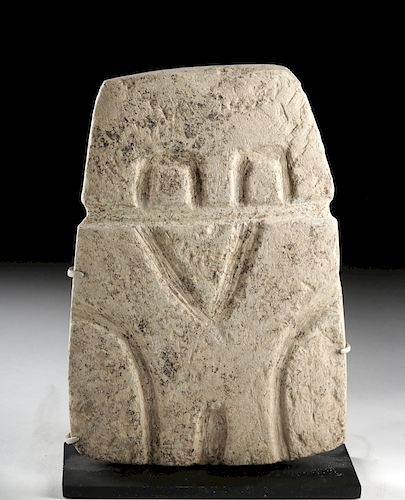Valdivian Limestone Plaque - Highly Abstract Owl
Lot 257
About Seller
Artemis Gallery
686 S Taylor Ave, Ste 106
Louisville, CO 80027
United States
Selling antiquities, ancient and ethnographic art online since 1993, Artemis Gallery specializes in Classical Antiquities (Egyptian, Greek, Roman, Near Eastern), Asian, Pre-Columbian, African / Tribal / Oceanographic art. Our extensive inventory includes pottery, stone, metal, wood, glass and textil...Read more
Estimate:
$3,000 - $4,500
Absentee vs Live bid
Two ways to bid:
- Leave a max absentee bid and the platform will bid on your behalf up to your maximum bid during the live auction.
- Bid live during the auction and your bids will be submitted real-time to the auctioneer.
Bid Increments
| Price | Bid Increment |
|---|---|
| $0 | $25 |
| $300 | $50 |
| $1,000 | $100 |
| $2,000 | $250 |
| $5,000 | $500 |
| $10,000 | $1,000 |
| $20,000 | $2,500 |
| $50,000 | $5,000 |
| $100,000 | $10,000 |
| $200,000 | $20,000 |
About Auction
By Artemis Gallery
Jan 7, 2020
Set Reminder
2020-01-07 10:00:00
2020-01-07 10:00:00
America/New_York
Bidsquare
Bidsquare : VARIETY AUCTION - Antiquities / Ethnographic
https://www.bidsquare.com/auctions/artemis-gallery/variety-auction---antiquities-ethnographic-4787
Around the world & back in time - be amazed at the treasures you will find. Antiquities from Egypt, Greece, Italy and the Near East, Asian, Pre-Columbian, African / Tribal / Oceanic, Native American, Spanish Colonial, Russian Icons, Fine Art, much more! Artemis Gallery info@artemisgallery.com
Around the world & back in time - be amazed at the treasures you will find. Antiquities from Egypt, Greece, Italy and the Near East, Asian, Pre-Columbian, African / Tribal / Oceanic, Native American, Spanish Colonial, Russian Icons, Fine Art, much more! Artemis Gallery info@artemisgallery.com
- Lot Description
**Originally Listed At $1600**
Pre-Columbian, Ecuador, Earliest Horizon, Valdivian culture, ca. 2300 to 2000 BCE. A finely-carved limestone plaque depicting a highly-abstract owl with folded wings, petite legs, a trapezoidal head with square-form eyes, and a delineated neck line just above a downward-pointed triangular beak. The avian details are deeply carved with strong straight and angular lines along the obverse face, and the verso is unadorned. The aesthetic is remarkably in line with the penchant for minimalism that appeals to our modern sensibilities and, yet, bespeaks of the ancient world. Size: 5.7" W x 8.2" H (14.5 cm x 20.8 cm); 8.625" H (21.9 cm) on included custom stand.
Ancient stone stelae from Ecuador, like this example, are some of the oldest stone sculptures known to exist in the Americas, dating as far back as 3500 BCE. Certainly each stele is unique; however, they do share a few common characteristics. They are usually carved from a pearly grey stone and are for the most part "blockish" in form, though this example shows rounded contours. The four most prominent themes of ancient Valdivian artistry include owls like this example, the "serpent/arrow," the sun chart, and the star chart.
The owl was widely symbolic in the Pre-Columbian world. Owls were considered to be of shamanic importance by many, guiding humans on their journeys to other worlds, the divine, and death. In some cultures, an anthropomorphic owl represents a warrior of great prominence or a god of war. As a nocturnal bird of prey, the owl was also associated with night hunters, darkness, and even the underworld itself.
Provenance: private New York, New York, USA collection; ex-private Patrick Hardy collection, Texas, USA, 2000s
All items legal to buy/sell under U.S. Statute covering cultural patrimony Code 2600, CHAPTER 14, and are guaranteed to be as described or your money back.
A Certificate of Authenticity will accompany all winning bids.
We ship worldwide and handle all shipping in-house for your convenience.
#146360Head reattached to neck with some stabilization material along break lines. Minor abrasions and nicks to obverse, peripheries, and verso, with light encrustations. Light earthen deposits throughout.Condition
- Shipping Info
-
All shipping is handled in-house for your convenience. Your invoice from Artemis Gallery will include shipping calculation instructions. If in doubt, please inquire BEFORE bidding for estimated shipping costs for individual items.
-
- Buyer's Premium



 EUR
EUR CAD
CAD AUD
AUD GBP
GBP MXN
MXN HKD
HKD CNY
CNY MYR
MYR SEK
SEK SGD
SGD CHF
CHF THB
THB














